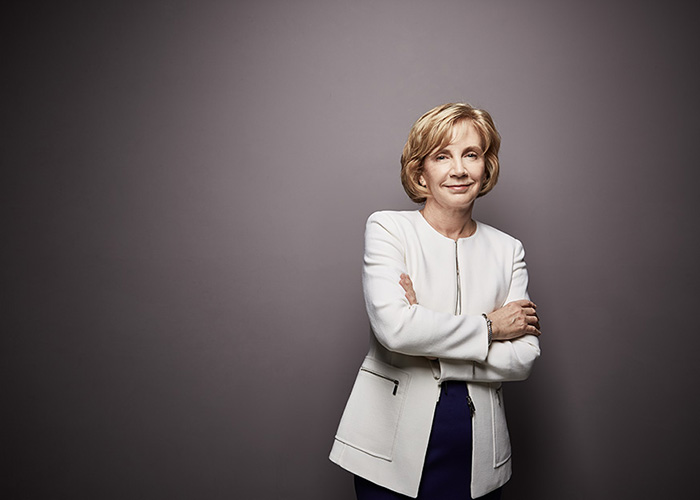Follow My Lead: Madelyn Caltabiano, PhD
As told to Amy Weaver
 Photos by Jared Castaldi
Photos by Jared Castaldi
January 24, 2019
BS Biological Sciences ’80
Senior Vice President,
Global Project & Alliance Management,
Merck Research Laboratories
For 37 years, Lyn Caltabiano has been a leader in the field of pharmaceutical research and development (R&D) at two of the top pharma companies in the world — GlaxoSmithKline and Merck & Co. From leading operations for GSK’s early phase clinical development and oncology R&D to strengthening project and alliance management at Merck, she has sought one challenge after the next, never allowing herself to get too comfortable. Underlying it all is a supreme respect for the work and her colleagues, and a passion for the field that began long before she ever stepped into a lab.
I knew I wanted to do research probably from the time — it’s silly — but from the time I was in middle school, all because of a series of Tang commercials. I kid you not.
There was a series of three, maybe four of them. Each one highlighted a woman scientist who was also a mother. One was a marine biologist, another was a physician, another was a developmental biologist.
Number of Vacation Days I Took Last Year:
30 days, my full allotment
My Book Recommendation for Aspiring Leaders:
“The Power of Positive Leadership” by Jon Gordon
On Work-Life Balance:
It’s not a balance; it’s a matter of continual prioritization. You can’t be a perfect parent, a perfect scientist, a perfect leader. But be clear about the things you won’t compromise on.
And I remember watching those commercials and thinking, “I want to do that.” It’s funny where
your inspiration comes from. I was always interested in science, and they were the only female scientist role models I had at the time, but it made a lasting impression.
When I got to Drexel, I did two of my three co-ops at Fox Chase Cancer Center. I was working in the lab of a Nobel Prize winner, Dr. Barry Blumberg, researching hepatitis.
I think it was partly because of my co-op that I got my first job as a bench scientist at what was then SmithKline & French Laboratories, and that started my whole career. The rest goes pretty quickly — 10 years in the lab, the first five of which I was working toward my PhD in pathology at the University of Pennsylvania; then 10 or so years in drug development, first as a project manager, and eventually leading development projects.
In my last decade at GlaxoSmithKline, I was offered a number of opportunities to step into what I would call R&D organizational leadership roles. One of the accomplishments I’m most proud of is creating the Alliance Management group.
Alliance managers are meant to be unbiased partnership experts, accountable for ensuring that collaborations between partner companies achieve their goals, adhere to contractual terms and are effectively governed. They also play a critical, integrative leadership role.
When I was creating the AM group, I had two important mentors who encouraged me to build a diverse team — a lesson I took with me into future leadership roles. It’s far too easy to hire people like yourself, when what you really need are leaders who have different perspectives and experiences, who can challenge not only your thinking, but also the thinking of the group.
When I was recruited to Merck in 2014, it was for the role I had always aspired to: to lead project management, and subsequently have accountability for alliance management, in an R&D organization. The challenge was to enhance the group’s leadership capabilities and to develop an integrated leadership team.
I enjoy and pride myself on building leaders, so I knew I wasn’t going to bring in a whole new team. I wanted to give myself time to get to know everyone, to understand their strengths, and to determine what I could and couldn’t shape.
Throughout my career, I’ve been fortunate to have had great bosses who were invested in my development. I’ve also observed the behavior of leaders around me — the good and the bad — and from there, developed my own philosophy on effective leadership.
One of the key attributes, I believe, is the ability to build high-performing teams and future leaders, to bring priority and focus to staff development and empowerment — and to know when to get out of your staff ’s way. You need to give yourself and your team permission to stumble, make mistakes, but then learn from those mistakes and move forward.

This requires the ability to give — and receive — honest, constructive feedback. I’ve seen too many of my colleagues struggle with this, but this kind of honesty is vital to individual and team growth.
Finally, a strong leader must be able to create and consistently communicate a clear, inspirational vision for the future — and be committed to its achievement.It is absolutely critical for employees to understand why our work matters, the role they have to play in it, and why achieving our vision is important.
Most people rally around that. I’ve found that the vast majority of people who commit their careers to pharmaceutical research and development do so because they want to make a difference. Pharma has had some bad press over the years and a few bad players who make it difficult for all of us — and I’m not saying the industry is entirely without blame — but I’ve seen how hard people work and what they give up to do the work that they do.
In 1977, when I was working in Dr. Blumberg’s lab at Fox Chase Cancer Center, I never imagined I would see the medical achievements that have been made in the last 40 years.
Back then, I was testing for what we called “non-A, non-B hepatitis,” a third hepatitis virus that could infect the liver and lead to chronic disease and subsequent death.
It didn’t have a definitive name then — it hadn’t even been isolated or sequenced — but it later became identified and known as hepatitis C.
I have a very good friend whose husband died 15 years ago from liver failure caused by hepatitis C.
Today, thanks to the efforts of many, hepatitis C patients can be cured.
To be at this point in my career and to have had the privilege of working with and leading passionate teams in an industry making these things happen — it’s incredible.
* This article originally appeared in the College of Arts and Sciences' Ask magazine feature story, “Follow my Lead.” For more Ask stories, visit askmagazine.org.